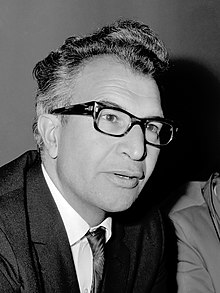Dave Brubeck | |
|---|---|
 Brubeck at Amsterdam Airport Schiphol in 1964 | |
| Background information | |
| Birth name | David Warren Brubeck |
| Born | December 6, 1920 Concord, California, U.S. |
| Died | December 5, 2012 (aged 91) Norwalk, Connecticut, U.S. |
| Genres | |
| Occupations |
|
| Instrument | Piano |
| Discography | Dave Brubeck discography |
| Years active | 1940s–2012 |
| Labels | |
| Website | davebrubeck |
David Warren Brubeck (/ˈbruːbɛk/; December 6, 1920 – December 5, 2012) was an American jazz pianist and composer. Often regarded as a foremost exponent of cool jazz, Brubeck's work is characterized by unusual time signatures and superimposing contrasting rhythms, meters, tonalities, and combining different styles and genres, like classic, jazz, and blues.
Born in Concord, California, Brubeck was drafted into the US Army, but was spared from combat service when a Red Cross show he had played at became a hit. Within the US Army, Brubeck formed one of the first racially diverse bands. In 1951, Brubeck formed the Dave Brubeck Quartet, which kept its name despite shifting personnel. The most successful—and prolific—lineup of the quartet was the one between 1958 and 1968. This lineup, in addition to Brubeck, featured saxophonist Paul Desmond, bassist Eugene Wright and drummer Joe Morello. A U.S. Department of State-sponsored tour in 1958 featuring the band inspired several of Brubeck's subsequent albums, most notably the 1959 album Time Out. Despite its esoteric theme and contrarian time signatures, Time Out became Brubeck's highest-selling album, and the first jazz album to sell over one million copies. The lead single from the album, "Take Five", a tune written by Desmond in 5
4 time, similarly became the highest-selling jazz single of all time.[1][2][3] The quartet followed up Time Out with four other albums in non-standard time signatures, and some of the other songs from this series became hits as well, including "Blue Rondo à la Turk" (in 9
8) and "Unsquare Dance" (in 7
4). Brubeck continued releasing music until his death in 2012.
Brubeck's style ranged from refined to bombastic, reflecting both his mother's classical training and his own improvisational skills. He expressed elements of atonality and fugue. Brubeck, with Desmond, used elements of West Coast jazz near the height of its popularity, combining them with the unorthodox time signatures seen in Time Out. Like many of his contemporaries, Brubeck played into the style of the French composer Darius Milhaud, especially his earlier works, including "Serenade Suite" and "Playland-At-The-Beach". Brubeck's fusion of classical music and jazz would come to be known as "third stream", although Brubeck's use of third stream would predate the coining of the term. John Fordham of The Guardian commented: "Brubeck's real achievement was to blend European compositional ideas, very demanding rhythmic structures, jazz song-forms and improvisation in expressive and accessible ways."[4]
Brubeck was the recipient of several music awards and honors throughout his lifetime. In 1996, Brubeck received a Grammy Lifetime Achievement Award. In 2008, Brubeck was inducted into the California Hall of Fame, and a year later, he was given an honorary Doctor of Music degree from Berklee College of Music. Brubeck's 1959 album Time Out was added to the Library of Congress' National Recording Registry in 2005. Noted as "one of Jazz's first pop stars" by the Los Angeles Times, Brubeck rejected his fame, and felt uncomfortable with Time magazine featuring him on the cover before Duke Ellington.[5]
- ^ Cite error: The named reference
City of Concord news releasewas invoked but never defined (see the help page). - ^ "Jazz Music – Jazz Artists – Jazz News". Jazz.com. Archived from the original on August 30, 2012. Retrieved May 4, 2012.
- ^ Russonello, Giovanni (December 7, 2020). "'Take Five' Is Impeccable. 'Time Outtakes' Shows How Dave Brubeck Made It. - An album of previously unheard recordings from the "Time Out" sessions in 1959 reveals the making of a masterpiece". The New York Times. Retrieved December 9, 2020.
- ^ Cite error: The named reference
fordhamwas invoked but never defined (see the help page). - ^ Cite error: The named reference
latimeswas invoked but never defined (see the help page).